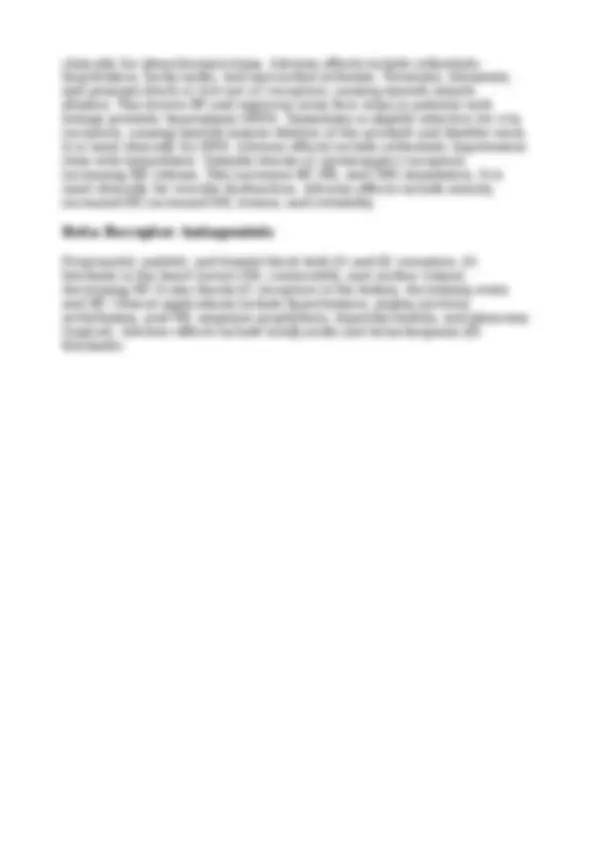



Study with the several resources on Docsity

Earn points by helping other students or get them with a premium plan


Prepare for your exams
Study with the several resources on Docsity

Earn points to download
Earn points by helping other students or get them with a premium plan
Community
Ask the community for help and clear up your study doubts
Discover the best universities in your country according to Docsity users
Free resources
Download our free guides on studying techniques, anxiety management strategies, and thesis advice from Docsity tutors
This document offers a comprehensive overview of adrenergic pharmacology, covering agonists and antagonists. it details the mechanisms of action, clinical applications, and side effects of various adrenergic compounds, including direct-acting, indirect-acting, and mixed agonists, as well as selective and non-selective antagonists. Highly structured and provides a clear explanation of complex pharmacological concepts.
Typology: Summaries
1 / 3

This page cannot be seen from the preview
Don't miss anything!


Indirect agonists elevate catecholamine levels at the synapse without directly binding to receptors. Examples include amphetamine, cocaine, and tyramine.
These drugs mimic the actions of epinephrine or norepinephrine, producing "fight or flight" responses.
Adrenoreceptors are classified into alpha (α) and beta (β) types, each with subtypes. α1 receptors cause smooth muscle contraction and mydriasis. α receptors have mixed smooth muscle effects. β1 receptors increase cardiac chronotropic and ionotropic effects. β2 receptors cause bronchodilation. β receptors increase lipolysis.
Dobutamine is an agonist that induces positive ionotropic effects, increasing the force of contraction. It is used clinically for acute heart failure and cardiogenic shock. Adverse effects include tachycardia, arrhythmias, hypertension, chest pain, and shortness of breath.
Albuterol is a short-acting beta2-agonist (SABA) that causes bronchial smooth muscle dilation, decreasing bronchospasms. It is a bronchodilator used for asthma and COPD, administered via inhaler or nebulizer. Adverse effects include tachycardia and tremor. Terbutaline causes systemic smooth muscle relaxation, leading to bronchial dilation for asthma and COPD, and uterine relaxation to slow preterm labor contractions.
Oxymetazoline is an alpha-1 and alpha-2 agonist. Its main effect is α1- mediated vasoconstriction, with partial α2 activity sustaining the vasoconstriction longer. It is used topically for nasal congestion, epistaxis,
and eye redness. Epinephrine is an alpha-1, alpha-2, beta-1, and beta- agonist. It causes α1-mediated vasoconstriction, increasing BP; α2-mediated inhibition of NE release; β1-mediated increases in HR, contractility, and conduction velocity; and β2-mediated bronchodilation. It is used for anaphylaxis, cardiac arrest, and shock. Adverse effects include tachycardia, arrhythmias, hypertension, stroke, and tremor. Norepinephrine is an alpha-1, alpha-2, and beta-1 agonist. It causes strong α1-mediated vasoconstriction, increasing BP; α2-mediated inhibition of NE release; and β1-mediated increases in HR and contractility. It has minimal β2 effects. It is used for septic shock, neurogenic shock, and hypotension during anesthesia. Adverse effects include severe hypertension, reflex bradycardia, arrhythmias, and peripheral ischemia.
Ephedrine is an alpha-1, alpha-2, beta-1, and beta-2 agonist and releasing agent. It was the first orally active sympathomimetic drug, found in ma huang. It has CNS activity, acting as a mild stimulant. Pseudoephedrine is used as a nasal decongestant. OTC purchase restrictions are in place due to its use in methamphetamine production.
Amphetamine promotes the release of NE, DA, and serotonin, and also inhibits reuptake. Tyramine displaces NE from storage vesicles in nerve terminals, especially in MAO-inhibited patients. Cocaine blocks NE/DA reuptake via transporter inhibition, increasing NE, DA, and serotonin. Imipramine increases NE and serotonin. It is used for depression and anxiety. Adverse effects include increased BP, arrhythmias, CNS stimulation, and seizures (cocaine). Monoamine oxidase inhibitors (MAO-Is) prevent the breakdown of catecholamines inside the neuron, increasing NE, DA, and serotonin levels. Nonselective MAO-A and B inhibitors include phenelzine and tranylcypromine. Selegiline is a MAO-B selective inhibitor. They are used for atypical depression and treatment-resistant major depressive disorder. Adverse effects include the "cheese effect" and serotonin syndrome.
Alpha receptor antagonists include nonselective agents like phentolamine, α1-selective agents like terazosin and tamsulosin, and α2-selective agents like yohimbe. Beta receptor antagonists include nonselective agents like propranolol and β1-selective agents like metoprolol. Labetalol is a nonselective beta and alpha-1 blocking agent.
Phenoxybenzamine irreversibly blocks α1 and α2 receptors, causing vasodilation and lowering BP. HR rises due to baroreflex activation. Phentolamine reversibly blocks α1 and α2 receptors, causing vasodilation and lowering BP. It has a shorter duration of tachycardia. It is used